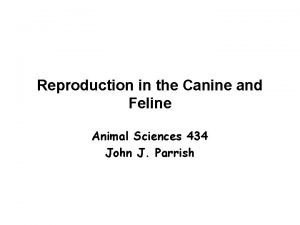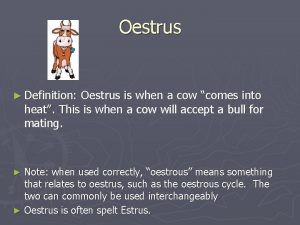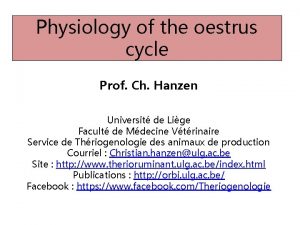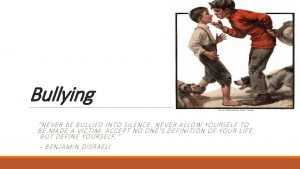DIXSON CH 6 The Oestrus That Never Was









































- Slides: 41

DIXSON CH. 6 The Oestrus That Never Was

Human menstrual cycle


Oestrus vs. concealed ovulation � Two 1. 2. questions: Does the species have oestrus or not? Does the species have external physical signs of ovulation?

Oestrus � Oestrus is defined as the ovarian hormonal control of female sexual behavior, such that female receptivity (and therefore copulations) are restricted to a very brief window around the time of ovulation, when conception is most likely to occur

Visible signs of ovulation Some animals exhibit physical signs of ovulation, external cues � Example: sexual skin swellings which are dependent on oestrogen � May take several days or longer to reach full tumescence, then begins to break down as soon as ovulation has occurred � Not necessarily related to oestrus �

For many years, and still today, people confuse “oestrus” with visible signs of ovulation � Old World Monkeys, Apes, and Humans – Anthropoids – have menstrual cycles, but they do not have oestrus � Some have obvious physical signs of ovulation � Some do not – some have concealed ovulation �

Humans are not unique Concealed ovulation is not unique to humans; many other anthropoids have concealed ovulation � Loss of oestrus is not unique to humans; none of the anthropoids have oestrus; only the prosimians (Strepsirhini) and tarsiers have true oestrus �

Why do primates have sex when they do? � 1. 2. 3. Three components Female attractiveness to males Female proceptivity – female initiation/solicitation of sex from male Female receptivity – female willingness to accept male advances

Female attractiveness � � Affected by ovarian hormones Leads to increased sexual activity during follicular phase and mid-cycle Includes male attention to female sexual swellings, if present, as well as the smell of her vagina When the female is “attractive” to the male, he will pursue her more assertively for mating

Female proceptivity � � Female initiates sexual activity May move in front of male and present rump May make eye contact as a way to elicit male attention – “eye-contact proceptivity” A result of neuroendrocine mechanisms different from those that govern receptivity

Female receptivity � � Willingness of female to allow male to mount her and have sex In primates (and other mammals) who have oestrus, this is a tightly circumscribed period of time, right around the time of ovulation, during which the females will allow the male to have sex (and at other times she will not allow the male to have sex with her)

� “The propensity for females monkeys and apes (and humans) to display sexual receptivity at times other than when ovulation is likely is widespread. . . ” � “Mutual attractiveness is an important determinant of copulatory frequency” � When able, females often decline male attempts to mate

� “. . . cyclical changes in the effects of ovarian hormones upon the brain and sexual behavior certainly occur in anthropoids, but they are subtle, situation dependent, and more influenced by variations in mutual attractiveness between the sexes than is the case for many mammals. Hence the term “oestrus” is no more appropriate when applied to descriptions of sexual behavior in female monkeys or apes, than it would be in descriptions of human sexuality. ”

Results of removal of ovaries � Common marmoset – females remain sexually receptive and sexually proceptive after removal of ovaries and adrenal glands

Conclusions � � “A relaxation of rigid hormonal control of female sexual behaviour is a trait shared by the anthropoids in general. ” “Loss of oestrus is an ancient phenomenon. ” “The evolution of sexual skin swellings in the chimpanzees and bonobos may have occurred after the common ancestors of these apes diverged from the line which ultimately gave rise to Homo. ” “Sexual skin swellings have arisen and have been lost a number of times during anthropoid evolution. ”

Evidence that anthropoid primates do not have oestrus � � Extended time when female is receptive, throughout cycle, even though frequency is higher in follicular phase and at mid-cycle Removal of ovaries does not affect receptivity

Difference between proceptivity and receptivity Mary Small & sense of hunger – she no longer gets hungry (pro. ), but is almost always willing to eat (rec. ) Kathy Dettwyler & sense of thirst – she lost her sense of thirst (pro. ) to chemotherapy for cancer, but is almost always willing to drink (rec. ) (as long as the liquid is not plain water, which makes her gag, a not-uncommon side effect of chemotherapy)

Lovejoy, et al. � Claimed that “loss of oestrus” � Is unique to humans � Evolved after hominid line split from other Great Apes � Translates into “females are always willing to have sex” � Claimed that “concealed ovulation” � Is unique to humans � Contributed to evolution of pair-bonding in humans � Males had to “mate guard” all the time to ensure paternity � Males got more sex in exchange for provisioning of female and offspring

Fisher, Burley � � � Helen Fisher argued that the unique loss of oestrus/concealed ovulation allowed women more opportunities for extra-pair copulations Such confusion of paternity might then have protected offspring from infanticidal males Nancy Burley argued that the same features, unique to human females, made it more difficult for women to avoid conception because they themselves didn’t know when they were ovulating

Mittelschmerz � � Mittelschmerz (German: "middle pain") is a medical term for "ovulation pain" or "midcycle pain". About 20% of women experience mittelschmerz, some every cycle, some intermittently. Ovulation can also be detected through �Keeping track of basal body temperature (spikes at ovulation) �Keeping track of changes in various characteristics of cervical/vaginal mucous

Natural Family Planning http: //www. ccli. org/ � The Couple to Couple League � Use of long-term breastfeeding, tracking of ovulation through various techniques, and abstinence when ovulating to space children without the use of contraceptives �

Human menstrual cycle & sexual behavior � � Handout on comparison of EEA vs. modern Western women’s experience of menstruation Menstrual cycles relatively rare for most of human evolution, prehistory, and still in much of the world today, due to: � Later menarche (mean = 15 years) � Early first pregnancy � Long periods of lactational amenorrhea � Many subsequent cycles of preg. /lact amen. � Earlier menopause (mean = 45 years)

Modern women, sexual frequency, & stage of menstrual cycle � Study Figure 6. 10 � On average, about 28% of women having sex on any given day � Sex more frequent in follicular phase of cycle, peaking on day before ovulation, then falling off rapidly � Very similar to pattern seen in other primates, including those who have obvious external signs of ovulation � Wilcox et al. (2004) also found that women tend to have sex more on the weekends

� � A few other studies have suggested more proceptive behavior in women on days right around ovulation Some evidence that, during the most fertile part of her cycle (peri-ovulation) women prefer: �More masculine faces (rated as more sexy/attractive) �The smell of men who are more symmetrical �Taller men �Men who are socially dominant or competitive






Is George Clooney the new Cary Grant?



Together in “Lawrence of Arabia”

Dual-Mating Strategies � � These data have been used to support the idea that women pursue dual-mating strategies – looking for different sets of traits depending on whether they are looking for a long-term relationship, a pleasant companion, a good provider, or a short-term relationship that will provide “good genes” for their offspring Symmetry, height, and more masculine faces = good genes

Assumptions about female choice � All these theories are assuming that women are: �Free to choose who they wish to marry and who they wish to have short-term relationships with �That they are able to attract the object of their desire (that the feelings are mutual)

Dixson is skeptical. . . � Of the dual-mating strategy hypothesis, b/c �He thinks that shifts in preferences of women during different stages of their cycles are not large or meaningful, and the research is done under artificial conditions �He points out that humans tend to form longterm partnerships for mating and raising children, and �That marriage is almost universal among human cultures �That “romantic love is a universal human attribute”

Dettwyler’s concerns � � I agree with Dixson that the dual-mating strategy argument is not well-supported by the evidence I agree that almost every human culture has marriage, and that romantic love is a universal human attribute I agree that having adult males contribute to the care and provisioning of children aids in the survival of said offspring However. . .

� � � In many cultures that have romantic love, it is not necessarily the basis for marriage, and is not necessarily linked to sexual behavior A woman (or a man) may very well fall in love with someone, but that doesn’t mean they can be married to that person (ex: Romeo & Juliet) Romantic love can flourish between two people of opposite sex, or between two people of the same sex, and yet not involve any sexual behavior

Pre-eclampsia � � � Interesting data on pre-eclampsia, which suggests that women are better off if they stick with a longterm partner (and if they have been with him for some time before getting pregnant by him) 10% of human pregnancies are affected by severe hypertension, known as pre-eclampsia, due to immunological incompatibility between mother and fetus Over time, a woman’s immune system becomes habituated to her partner’s seminal products, thus reducing the risk of pre-eclampsia

Conclusions � “Comparative studies indicate that a rigid neuroendocrine control of female receptivity and proceptivity during the peri-ovulatory period was lost in ancestral anthropoids. Thus, extant monkeys and apes, as well as women, lack oestrus, whilst it is still present among the prosimian primates. ” � We don’t know why this loss of oestrus occurred, or why some anthropoids have concealed ovulation, but it isn’t to facilitate pair -bonding, or confuse paternity, or to reduce male infanticide in humans uniquely.
 Panday (2005 tv series)
Panday (2005 tv series) L'oestrus
L'oestrus Dog cum
Dog cum Block xoang nhĩ độ 2 type 1
Block xoang nhĩ độ 2 type 1 Tìm vết của đường thẳng
Tìm vết của đường thẳng Sau thất bại ở hồ điển triệt
Sau thất bại ở hồ điển triệt Thể thơ truyền thống
Thể thơ truyền thống Con hãy đưa tay khi thấy người vấp ngã
Con hãy đưa tay khi thấy người vấp ngã Thơ thất ngôn tứ tuyệt đường luật
Thơ thất ngôn tứ tuyệt đường luật Tôn thất thuyết là ai
Tôn thất thuyết là ai Phân độ lown ngoại tâm thu
Phân độ lown ngoại tâm thu Walmart thất bại ở nhật
Walmart thất bại ở nhật Gây tê cơ vuông thắt lưng
Gây tê cơ vuông thắt lưng He never polishes his shoes, so he never looks smart
He never polishes his shoes, so he never looks smart God never fails
God never fails Love never fails it never gives up
Love never fails it never gives up Can run but never walks has mouth
Can run but never walks has mouth He never polishes his shoes so he never looks smart
He never polishes his shoes so he never looks smart We are never never weary
We are never never weary Chó sói
Chó sói ưu thế lai là gì
ưu thế lai là gì Thẻ vin
Thẻ vin Tư thế ngồi viết
Tư thế ngồi viết Cái miệng nó xinh thế
Cái miệng nó xinh thế Trời xanh đây là của chúng ta thể thơ
Trời xanh đây là của chúng ta thể thơ Thế nào là hệ số cao nhất
Thế nào là hệ số cao nhất Từ ngữ thể hiện lòng nhân hậu
Từ ngữ thể hiện lòng nhân hậu Tư thế ngồi viết
Tư thế ngồi viết V cc cc
V cc cc Các châu lục và đại dương trên thế giới
Các châu lục và đại dương trên thế giới Tư thế worm breton
Tư thế worm breton Sự nuôi và dạy con của hổ
Sự nuôi và dạy con của hổ Diễn thế sinh thái là
Diễn thế sinh thái là Vẽ hình chiếu vuông góc của vật thể sau
Vẽ hình chiếu vuông góc của vật thể sau Các châu lục và đại dương trên thế giới
Các châu lục và đại dương trên thế giới Mật thư anh em như thể tay chân
Mật thư anh em như thể tay chân Bổ thể
Bổ thể Thế nào là mạng điện lắp đặt kiểu nổi
Thế nào là mạng điện lắp đặt kiểu nổi Lời thề hippocrates
Lời thề hippocrates Vẽ hình chiếu đứng bằng cạnh của vật thể
Vẽ hình chiếu đứng bằng cạnh của vật thể đại từ thay thế
đại từ thay thế





























































